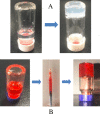Amyloid-Based Injectable Hydrogel Derived from Hydrolyzed Hen Egg White Lysozyme
- PMID: 31459897
- PMCID: PMC6648635
- DOI: 10.1021/acsomega.8b03492
Amyloid-Based Injectable Hydrogel Derived from Hydrolyzed Hen Egg White Lysozyme
Abstract
Injectable hydrogels based on synthetic peptides have shown great promise in many biomedical applications. Yet, the high cost generally associated with synthetic peptides hinders the practical use of such peptide-based injectable hydrogel. To overcome this drawback, here, we propose to use the peptides from hydrolyzed low-cost natural protein as an economical and convenient peptide source to prepare an injectable hydrogel. We demonstrate the effectiveness of this alternative strategy using hen egg white lysozyme (HEWL) as an example. We used the peptide fragments from hydrolyzed HEWL as the gelator, and the magnesium ion as the performance enhancer to prepare the injectable hydrogel. We showed that the hydrogel is an amyloid gel as it was formed by a dense network of amyloid fibrils. We also showed that the hydrogel possesses a thixotropic property and displays a low cytotoxicity. The hydrolysis extent of HEWL was found to be a critical factor that influences the performance of the hydrogel. A fluorescence assay based on 8-anilinonaphthalene-1-sulfonic acid was proposed as a mean to precisely and conveniently control the hydrolysis extent of HEWL to enable the best injectability performance. At last, using doxorubicin as a model compound, we explored the potential of this amyloid-based hydrogel as an injectable drug carrier.
Conflict of interest statement
The authors declare no competing financial interest.
Figures










Similar articles
-
Lysozyme amyloidogenesis is accelerated by specific nicking and fragmentation but decelerated by intact protein binding and conversion.J Mol Biol. 2007 Feb 23;366(3):1029-44. doi: 10.1016/j.jmb.2006.11.084. Epub 2006 Dec 2. J Mol Biol. 2007. PMID: 17196616
-
Formation of hen egg white lysozyme derived amyloid-based hydrogels using different gelation agents: A potential tool for drug delivery.Int J Biol Macromol. 2023 Dec 31;253(Pt 5):127177. doi: 10.1016/j.ijbiomac.2023.127177. Epub 2023 Sep 30. Int J Biol Macromol. 2023. PMID: 37783247
-
Repression Effects of Hydrolysates from Hen-Egg Proteins on Amyloid Fibril Formation.J Poult Sci. 2022 Oct 25;59(4):384-391. doi: 10.2141/jpsa.0220038. J Poult Sci. 2022. PMID: 36348649 Free PMC article.
-
The formation of amyloid fibrils from proteins in the lysozyme family.Curr Protein Pept Sci. 2007 Dec;8(6):537-57. doi: 10.2174/138920307783018659. Curr Protein Pept Sci. 2007. PMID: 18220842 Review.
-
Polyethylene glycol (PEG)-Poly(N-isopropylacrylamide) (PNIPAAm) based thermosensitive injectable hydrogels for biomedical applications.Eur J Pharm Biopharm. 2014 Nov;88(3):575-85. doi: 10.1016/j.ejpb.2014.07.005. Epub 2014 Aug 1. Eur J Pharm Biopharm. 2014. PMID: 25092423 Review.
Cited by
-
Amyloid-Based Albumin Hydrogels.Adv Healthc Mater. 2023 Mar;12(7):e2201748. doi: 10.1002/adhm.202201748. Epub 2022 Dec 18. Adv Healthc Mater. 2023. PMID: 36469813 Free PMC article.
-
Substitution of tyrosine with electron-deficient aromatic amino acids improves Ac-PHF6 self-assembly and hydrogelation.RSC Adv. 2025 Jun 30;15(28):22216-22227. doi: 10.1039/d5ra03251b. eCollection 2025 Jun 30. RSC Adv. 2025. PMID: 40599564 Free PMC article.
-
A Diphenylalanine Based Pentapeptide with Fibrillating Self-Assembling Properties.Pharmaceutics. 2023 Jan 21;15(2):371. doi: 10.3390/pharmaceutics15020371. Pharmaceutics. 2023. PMID: 36839694 Free PMC article.
-
Novel Delivery of Cyclic-Diguanylate Monophosphate Utilizing Amyloid Depots.Pharmaceutics. 2025 May 19;17(5):668. doi: 10.3390/pharmaceutics17050668. Pharmaceutics. 2025. PMID: 40430958 Free PMC article.
-
Genetically Engineered Protein-Based Bioadhesives with Programmable Material Properties.ACS Appl Mater Interfaces. 2023 Dec 13;15(49):56786-56795. doi: 10.1021/acsami.3c12919. Epub 2023 Dec 1. ACS Appl Mater Interfaces. 2023. PMID: 38039085 Free PMC article.
References
LinkOut - more resources
Full Text Sources

